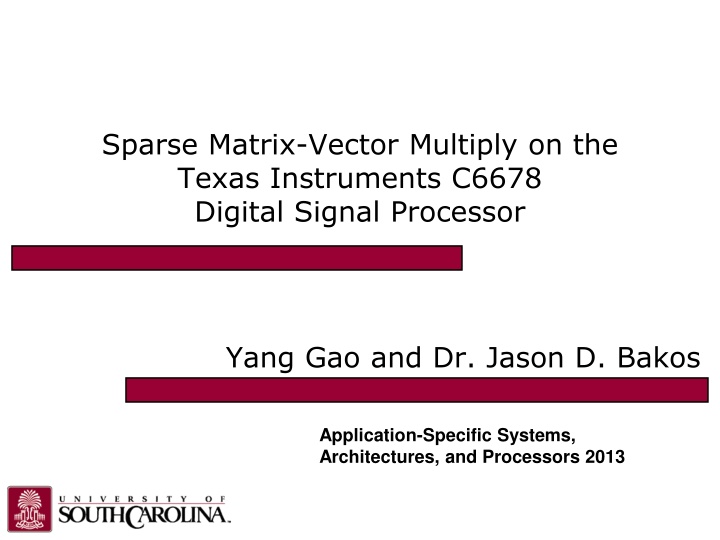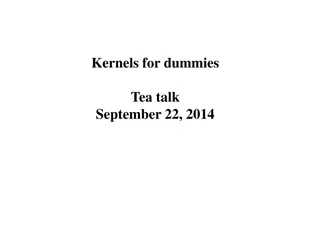
Sparse Matrix-Vector Multiply on Texas Instruments C6678 DSP
Explore the unique architectural features of Texas Instruments C6678 Digital Signal Processor and its efficiency compared to competing coprocessors like NVIDIA Tesla K20X GPU and Intel Xeon Phi 5110p. Learn about software pipelining, sparse matrices evaluation, and code implementation for matrix-vector multiplication.
Download Presentation

Please find below an Image/Link to download the presentation.
The content on the website is provided AS IS for your information and personal use only. It may not be sold, licensed, or shared on other websites without obtaining consent from the author. If you encounter any issues during the download, it is possible that the publisher has removed the file from their server.
You are allowed to download the files provided on this website for personal or commercial use, subject to the condition that they are used lawfully. All files are the property of their respective owners.
The content on the website is provided AS IS for your information and personal use only. It may not be sold, licensed, or shared on other websites without obtaining consent from the author.
E N D
Presentation Transcript
Sparse Matrix-Vector Multiply on the Texas Instruments C6678 Digital Signal Processor Yang Gao and Dr. Jason D. Bakos Application-Specific Systems, Architectures, and Processors 2013
TI C6678 vs. Competing Coprocessors NVIDIA Tesla K20X GPU Intel Xeon Phi 5110p Coprocessor Peak single precision performance Memory bandwidth TI C66 3.95 Tflops/s 2.12 Tflops/s 128 Gflops/s 250 GB/s 320 GB/s 12.8 GB/s Power 225 W 225 W 10 W None, but OpenMP/ OpenCL in development Primary programming CUDA/OpenCL OpenMP model 2
Why the C6678? Unique architectural features 8 symmetric VLIW cores with SIMD instructions, up to 16 flops/cycle No shared last level cache 4MB on-chip shared RAM L1D and L2 can be configured as cache, scratchpad, or both DMA engine for parallel loading/flushing scratchpads Power efficiency At 45 nm, achieves 12.8 ideal SP Gflops/Watt Intel Phi [22 nm] is 9.4 Gflops/Watt NVIDIA K20x [28 nm] is 17.6 Gflops/Watt Fast on-chip interfaces for potential scalability 4 x Rapid IO(SRIO) 2.1: 20 Gb/s 1 x Ethernet: 1 Gb/s 2 x PCI-E 2.0: 10 Gb/s HyperLink: 50 Gb/s 3
Software Pipelining Regular Loop Software Pipelining VLIW architecture requires explicit usage of functional units Time 1 1 C66 compiler uses software pipelining to maximize FU utilization 1 1 2 Prolog 1 1 2 3 Kernel Conditional prevents SP and lowers utilization 2 3 2 Epilog 3 2 ALU1 ALU2 ALU3 2 5
Sparse Matrices We evaluated the C66 relative using a SpMV kernel GPUs achieve only 0.6% to 6% of their peak performance with CSR SpMV Sparse Matrices can be very large but contain few non-zero elements Compressed formats are often used, e.g. Compressed Sparse Row (CSR) 1 -2 0 -4 0 -1 5 0 0 8 0 0 4 2 0 -3 0 6 7 0 0 0 4 0 -5 val (1 -1 -3 -2 5 4 6 4 -4 2 7 8 -5) col (0 1 3 0 1 2 3 4 0 2 3 1 4) ptr (0 3 5 8 11 13) 6
Sparse Matrix-Vector Multiply Code for y = A x + y conditional execution row = 0 for i = 0 to number_of_nonzero_elements do if i == ptr[row+1] then row=row+1, y[row]*=beta; y[row] = y[row] + alpha * A[i] * x[col[i]] end Low arithmetic intensity (~3 flops / 24 bytes) Memory bound kernel indirect indexing reduction 7
Nave Implementation for i = columns assigned to current core y write back index i ptr buffer y buffer val array col array row if ptr[row] == i then row = row +1 y[row] y[row] * end if y[row] y[row]+Acc x array product results Acc * val * x 0.55 Gflops/s 60.4% of cycles were uncovered memory latency 8
Double Buffer and DMA Product Loop index i SDRAM buffer val buffer buffer Val L2 col buffer buffer Col L2 DMA x buffer * val * x DSP 0.78 Gflops/s 28.8% of cycles were uncovered memory latency 9
Loop Unroll and Predicate Instruction Accumulate Loop y write back i ptr buffer y buffer row The accumulate loop is manually unrolled by 8 Acc Acc + prod[i] if ptr[row] == i then row = row +1 y[row] y[row] * end if y[row] y[row] * end if y[row] y[row] * +Acc end if Acc Acc + prod[i+1] if ptr[row] == i then row = row +1 if ptr[row] == i then row = row +1 prod buffer Acc Acc + prod[i+K] Predicate instructions are applied to replace the if-statements in assembly. 1.63 Gflops/s 50.1% cycles were uncovered memory latency 10
Loop Fission Accumulate Loop Product Loop y write back index i i ptr buffer y buffer val buffer col buffer row Acc Acc+prod[i] if ptr[row] == i then row = row +1 y[row] y[row]* +Acc end if x buffer prod buffer product results * val * x 2.08 Gflops/s 36.6% cycles were uncovered memory latency 11
Adaptive Row Pointer y write back Accumulate Loop i ptr buffer y buffer prod buffer row if(ptr[row+1]-ptr[row]) >K Acc Acc + prod[i] if ptr[row] == i then row = row +1 y[row] y[row] * end if y[row] y[row] * end if y[row] y[row] * end if Acc Acc + prod[i] Acc Acc + prod[i+1] Acc Acc + prod[i+K] Acc Acc + prod[i+1] if ptr[row] == i then row = row +1 if ptr[row] == i then row = row +1 Acc Acc + prod[i+K] 12
Test Environment i5 650 MKL Clarkdale GTX680 CUSPARSE Kepler GTX650Ti CUSPARSE Kepler C66 Architecture Shannon Process(nm) 32 28 28 45 Memory throughput (GB/s) 21 192.3 86.4 12.8 TDP (W) 73 195 110 10 Single precision performance (Gflops) 26 3090 1425 128 13
Power Analyzer Power Socket Provide by WT500 110 V PSU with EVM board 12 V 14
Matrix 2, 4, 0, 0, 0, 0 5, 4, 7, 0, 0, 0 0, 6, 2, 4, 0, 0 0, 0, 3, 10, 1, 0 0, 0, 0, 4, 6, 8 0, 0, 0, 0, 2, 12 Tri-diagonal N-diagonal 3 - 501 University of Florida sparse matrix collection Matrix Market 15
SpMV Performance N-diagonal Matrix Generally, the C66 achieves ~2/3 CPU performance 16
SpMV Gflops/Watt N-diagonal Matrix C66 is equivalent to GPUs when N > 51 17
Gflops/Watt for Nonsynthetic Matrices C66 power efficiency also scales with density for real-world matrices 18
Memory Efficiency 9 ???? ? + 8 ???? + 2 12(2 ???? ? + ? + 2 ???? + 1)???/???? ?? = N = 151 rows = 208326 ?? 12.8 19
Next Generation Keystone-II 28 nm Doubles caches Increases memory bandwidth by 125% 66AK2H12 Keystone-II C66 CPU n/a 4 x ARM A15 DSP 8 Cores 8 Cores DSP L2 512 KB 1024 KB DDR3 64 bit 2 x 72 bit Process 45 nm 28 nm Power 10 W ? 21
Conclusions TI DSP is a promising coprocessor technology for HPC Advantages: 1. Unique architectural features that facilitate automated parallelization (easier to program?) 2. Inherently power efficient microarchitecture Equivalent to modern GPUs and Phi despite older process technology 3. Has advanced memory system for memory bound kernels Simultaneous DMA and caching to match access pattern of indvidivual arrays 4. Has advanced onchip interfaces for efficient scalability Large-scale multi-DSP platforms already exist Looking forward: Keystone II will: 1. Improve efficiency and memory performance (cache + b/w) 2. Has onboard host CPUs to facilitate runtimes for multi-DSP scaling 22
Q & A 23
Arithmetic Intensity y write back index i ptr buffer 4 bytes y buffer 4 bytes val buffer 4 bytes col buffer 4 bytes row 1 op Acc Acc+prod[i] if ptr[row] == i then row = row +1 y[row] y[row]* +Acc end if x buffer 4 bytes 4/rows bytes 2 ops prod buffer * val * x n = average number of non-zero elements per row 2 ops 3??? 4 ????????? +1 2ops 12byts)/(1 +1 ?? = ( n n) 8 + 24






















